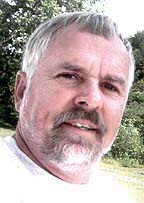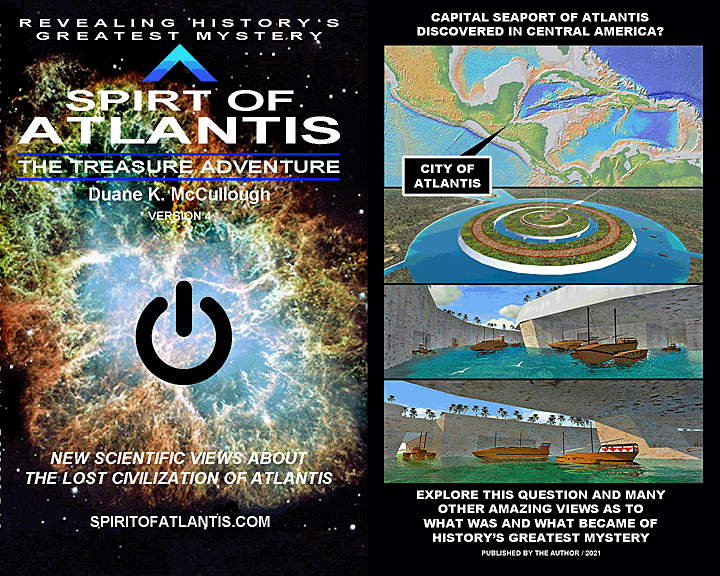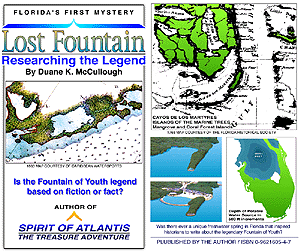

Duane: Well, yes -- let me post the cover images of what used to be my "book projects".

Image of the Spirit of Atlantis book covers.

Image of the Lost Fountain book covers.
Because both projects are now online works -- where I can easily update them regularly, I often take time to review the many theories within and try to find new ways to explain them during these interviews.
The scientific subjects of anthropology and archeology are used extensively in these projects to explore many new theories regarding the true origins of not just early humans -- but early modern humans.
Although there exist several popular anthropological theories regarding where on earth early modern humans came from that seem to be factual, what makes any theory truely factual is the archeological evidence that can prove and verify them as important concepts in studying human history.
For example, my radical anthropological theory that early modern humans -- once known as Modern Cro-Magnon Man, did not originate in the Old World, but came from the New World and nautically colonized the shores of the Old World thousands of years ago.
Now, to help prove this radical theory, I would have to explain several new archeological concepts as evidence that could prove or at least suggest early modern humans in the New World used modern technology to influence historical sites in the Old World.
An example of this theoretical concept is the archeological fact that because more modern Clovis Point spear heads have been found in the New World than in the Old World, the idea that the earliest tool of modern human technology -- the Clovis Point design, may have been invented by early modern humans who originated in the New World.
Moreover, another example that early modern humans may have originated in the New World is that the earliest form of a non-graphical lineal alphabet and numerical communication technology system is known as Ogam -- which, I believe, originated in the New World because of the historical evidence as explained in my research work.
The popular belief that early humans originated in Africa and "walked out" to the rest of the world and became "early modern humans" over time -- together with the common belief in the Carbon-14 isotope decay dating theory, have shaped conventional anthropological literature for over a half a century. However, perhaps the time is ripe to "think out of the box" long enough to explore other options in understanding the origins of early modern humans -- and I don't mean looking to off planet sources of alien life for why early humans became modern humans like some pseudo-scientist would have us believe.
So, if my novel theory is true in that early modern humans originated in the New World and "grew up" nautically exploring the entire world long before the Biblical Flood event of nearly a thousand years ago, then conventional anthropological and archeological theories need to be updated to reflect this view.
Although there exist many examples of early human activity throughout the Old World, something unique happened to the early humans in the New World that made them modern.
Perhaps some set of eugenics or euthenics projects were developed over time by somebody someplace that created modern humans from early humans.
Perhaps the experimental act of shaping human heads with skull boards made popular by some New World natives -- together with a unique diet of durable elements, created a type of modern human that was different from early humans of the world.
In any case, the novel theory that early modern humans originated somewhere in the New World, is a new theory which should be explored by modern anthropologist.
Reporter 2: Interesting set of theories. Could you elaborate on your theory regarding when and where these "eugenics or euthenics projects" you mentioned took place that may have created modern humans from early humans?
Duane: Okay -- let see, the concept of eugenics is based on the idea that humans can be "improved" or "made better" by modifying their genetic makeup through "cross-breeding programs". Eugenics can also include modifying body parts like "brain shaping techniques" using "skull boards". These ancient projects in experimenting with shaping and designing the human body long ago may explain how early humans became modern humans.
Early New World natives like the Mayans and Incans -- and even the early Egyptians of the Old World, were known to experiment in "head-shaping" projects. Again, these examples may be related to some forgotten ancient experimental eugenics project that may have "created" modern humans from early humans. Exactly when and where these eugenic experiments may have taken place is unknowable at this time.
By the way, I sometimes wonder if the Mayan or Incan natives -- and even the Egyptian peoples, ever refered to themselves as the names modern historians have called them. Makes one wonder how and when these groups of people were named. I also wonder how much of ancient history was made up by other historians trying to figure it all out.
Anyway, regarding the concept of euthenics -- which is based on improving humans using environmental means, the idea of creating healthy environments -- particularly a place where "super food" can be grown and be consumed properly, may have resulted in "super memory abilities" among the inhabitants.
For example, remember the Biblical story about how Adam and Eve, while in the Garden of Eden, once ate a healthy fruit that may have improved their memory in "knowing" or "remembering" right from wrong?
Well, much like the mythical "Golden Apples" story from the Hesperian Heavens that gave immortal-like qualities to whoever consumed them, perhaps certain apples were once grown with certain durable and nutritional elements that could improve not only the brain memory of early humans, but also the cell memory of other body parts.
It should be understood that the modern human ability to remember things in apparent infinite detail is what really separates man from animal.
Both of my research projects -- SPIRIT OF ATLANTIS and LOST FOUNTAIN, end with the idea that certain durable noble elements -- like gold, if consumed and assimilated properly, may improve the memory within all body cells, which could result in better health and longevity of the consumer because of the durable qualities of the element.
Moreover, another interesting element that I explain in my research projects, which may also result in cell longevity, is manganese. It seems that manganese and iron in the blood is somewhat interchangeable -- and because manganese does not oxidize easily as iron, it is capable of reducing "over oxidation events" in the body that can lead to "ageing events" which shortens the lifespan of cell life.
Perhaps the right amount of manganese -- that royal purple color element in amethyst crystals, when properly assimilated in the body, helped early humans become modern humans long ago.
So, the theory that a euthenics project -- based on nutrition, could have been once implemented by our Atlantean ancestors in prehistoric antediluvian times, may help explain the origins of modern humans.
Reporter 3: You have mentioned in past interviews about how the Carbon-14 isotope decay dating system theory is wrong -- and you just mentioned it again. Could you explain again why you believe this popular concept of dating historical artifacts is wrong?
Duane: It should be understood by modern historians that the Carbon-14 isotope decay dating theory, which is used to "date" artifacts beyond about a thousand years ago, is based on a formula of "adjustable trending tables of decay rates" -- and not on absolute factual evidence of dates. Therefore, it is only a working theory of dating prehistoric artifacts beyond the verification technique of "tree-ring" dating.
When it was "invented" in the early 1950's, it was mistakenly "calibrated" to the conventional dates of the B.C./A.D. timeline -- which has resulted in wrongful dates that have been "solitified" over the years by established historical institutions as "factual" timeline evidence of human history.
I mean, think about it for a moment -- if the Carbon-14 dating theory system did not match or corralate to the conventional dates of the B.C./A.D. timeline -- which we should now know is significantly wrong beyond about five centuries ago, it would never have been chosen as a scientific tool to measure the timeline of human history. Even today, the momentum of conventional recorded dates of human history beyond about five centuries ago is so strong, any new theory about the true timeline of human history seems false at face value unless the proper research proves otherwise.
If, in the future, the Carbon-14 dating theory system was "de-calibrated" from the conventional dates of the B.C./A.D. timeline, then it may actually be used to read the true timeline of human history. Until then, I believe the dating theory system is compromised and not to be trusted beyond about five centuries ago.
Reporter 1: What physical activity do you engage in when you are not working on your research projects?
Duane: Well, a few months ago, after deciding to replace a grass and weed area in the back yard with a rock garden, I have been physically building a "Japanese Garden" -- complete with stone pagodas, Bonsai Trees and even a Torii archway gate.
Before I started building anything, I studied the history and architectual makeup of japanese pagodas and archways and learned a lot about how to create simple designs that would make one happy while viewing the place from within the garden.
One basic element that I learned was to take a simple design -- either a pagoda or a Torii archway gate, and keep it simple. Don't be influeinced by traditional designs like "flaring edges" and "complex elements" common on many structures from other oriental designs.
It seems that the oldest examples of pagodas and Torii gates found in Japan were simple structures -- both the five story pagoda and the five stage stone lantern design can be quite interesting in their makeup.
I always wanted to believe pagodas were some kind of time-keeping temple -- much like the stepped Mayan pyramids, where days and seasons were somehow marked to show the time of year to the farmers of the area. But I could not find any four stage example of an oriental pagoda like the four sided Mayan pyramid in my Google image search that could suggest pagodas were ever used to tell seasonal time by visually marking certain stages.
So, I guess I was wrong -- however, while searching for pagoda images, I did come across images of an interesting device found in Egypt that looks like a four stage pagoda. It is called a "djed" -- and some theories about what it was and used for are quite interesting.
Theories about the Egyptian djed range from a ancient pulley design to some kind of prehistoric step transformer device that could power certain plasma lamps called Dendera lamps.
One more thing I could say about the pagoda temple design, the larger five story versions in Japan have a unique tall shaft tower at their top that looks like some kind of fancy "lightning rod" antenna. This is called a "sorin" that is part of the "finial" of the structure -- which according to the religious design rules of the structure, is ment to symbolize certain aspects of the religion.
In any case, researching structural items for designing a Japanese rock garden can get quite interesting.
As for the Japanese archway gate design -- the Torii I built as a gateway to the garden was made simple, but did include a very small angle of the two post toward each other and the ends of the top board were cut outward a little. I placed a small support square block in between the larger top cross-board and smaller cross-board with a cut-out zero hole to suggest the orib of the Sun and the zero-point energy of the number zero symbol.
The Torii archway represents a gateway from the profane to the divine -- or so it is believed. I like that concept.
Regarding the design of the stone lantern and Bonsai Trees in the garden, these relevant objects seem to be small models of larger things. The stone lantern represents a house in the woods that gives light to the darkness. And the Bonsai Trees represent much larger trees with a graceful shape that is pleasant to study.
Good Japanese rock garden designs seem to reflect a perfect miniature world of nature -- they inspire the mind and calm the soul. A great place to "Zen out" and not worry about the greater problems of the larger world we live in.
END 40th INTERVIEW 5/16
ATLANTEAN COMMUNICATIONS Page
Return to the Homepage site